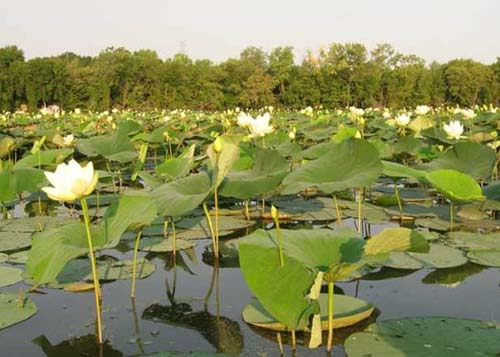American Lotus
Submersed stems of this native species (Nelumbo lutea) provide excellent habitat and cover for both invertebrates and the juvenile fish that eat them. The large canopy formed by American lotus is the perfect ambush opportunity for larger fish.

Seasonal Techniques
Spring—American lotus sprouts from seed or existing rhizomes (underground roots), and the leaf stem will begin to grow toward the surface where a leaf will begin growth from the end of the stem. As newly sprouted leaf stems emerge from the rhizome, fishing a jig or craw in and around these stems is recommended.
Summer—The plant will continue to rapidly grow, forming new plants along the rhizome all summer long. Large colonies of the plant will form along the shoreline with some leaves floating and others standing high above the water resembling a tuba. The formation of large leaves is the perfect opportunity to dissect large holes between leaves. An open understory can hold monster bass awaiting a meal.
Fall—Lotus will produce seed in large seed pods growing above the water’s surface. The green pods will begin to turn brown and face down where the seeds will be released. The large floating leaves will begin to die and wither in late fall. As many leaves stand erect in the fall, flipping the stem bases of these massive plants becomes a great opportunity. A frog can also be worked over the large leaves and into large holes between the plants.
Winter—American lotus will overwinter using its extensive rhizome network. American lotus will be less present in winter and targeting this specific plant should be avoided.
Habitat Value
Fish—Submersed stems of the plant provide excellent habitat and cover for both invertebrates and the juvenile fish that eat them. The large canopy formed by American lotus is the perfect ambush opportunity for larger fish.
Waterfowl—The large, acorn sized seeds of lotus are readily used by some waterfowl, and invertebrates using this species for habitat are also readily consumed by waterfowl.
Identifying Features
What It Looks Like—The extremely large, floating leaves of American lotus make it easily distinguishable from other floating leaf species. A large white flower and large seed pods also standout with this species.
Where to Find It—Grows in nearshore areas with substantial sediment and nutrients for growth.
Max Depth—0 to 5 feet
Similar Species—The flowers of fragrant water lily can resemble that of American lotus; however the large floating leaves of American lotus make it easily distinguishable from other species.
Drawbacks
American Lotus can sometimes cause water use issues, impeding boat use and swimming activities. Cost to manage: $$ out of $$$$$.
Contact Us
We're always looking for more information about aquatic plants on TVA reservoirs. Let us know where and what you see, and send us your photos. Email us.